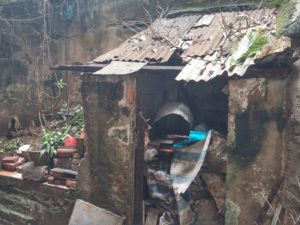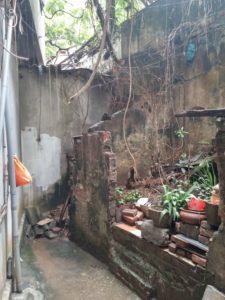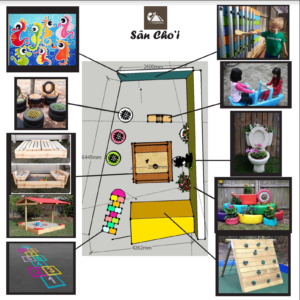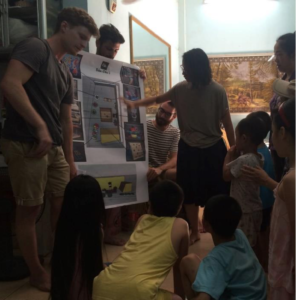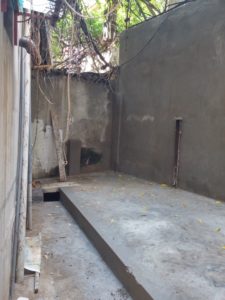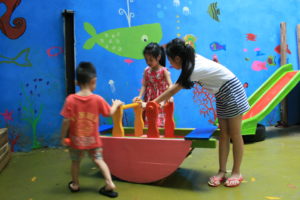CÔNG TÁC QUẢN LÝ
Cấu trúc của TPG là gì và tổ chức này có những kế hoạch ra sao?Các thành phố ở Việt Nam đã tăng trưởng mạnh mẽ kể từ khi nhà nước thực hiện công cuộc Đổi mới vào năm 1986. Sự phát triển này tạo áp lực lên các không gian công cộng vốn đã kém phù hợp với nhu cầu của trẻ em. TPG ra đời để giải quyết vấn đề này sau khi các chính sách của nhà nước trở nên mềm mỏng hơn đối với các tổ chức xã hội dân sự. Thông qua việc sử dụng các hoạt động DIY đô thị, tổ chức đặt mục tiêu giải quyết việc thiếu hụt không gian vui chơi cho trẻ em ở Hà Nội. Thành công của sáng kiến này cho thấy tầm quan trọng của việc thực hành DIY trong đô thị ở Việt Nam và cả những ngước phát triển, hiểu được sự ra đời của tổ chức, công tác vận hành của tổ chức và cách thức mà tổ chức phối hợp với các tổ chức khác hiện hành.

BỐI CẢNH
Civil Society in Vietnam
Civil society is a singular concept within the Vietnamese context, where the state is present at all levels and must approve all projects before they can move ahead. Civil society organizations are thus forced to interact by varying degrees with the public authorities, a situation which seems unorthodox within the Western conception of civil society. It’s therefore necessary to adopt a definition of civil society that’s based on the actors and their actions, and that understands that they behave independently of but not in opposition to the state, yet while not being free from state influence (Gray, 1999; Nørlund, 2007; Wischermann, 2010).
TẦM QUAN TRỌNG CỦA VUI CHƠI
Phát triển các kĩ năng tự chủ ở trẻ nhỏ là một trong các lợi ích chính đến từ việc vui chơi. Các nghiên cứu cho thấy, các kĩ năng học được trong khi chơi sau này trở nên có ích khi đi học và trong cuộc sống (Berk và Meyers, 2013; Kellock, 2015). Tuy nhiên, các nghiên cứu này chủ yếu được thực hiện ở các nước phát triển, và có các rào cản lớn khác có thể giải thích trình độ học vấn thấp ở Việt Nam. Mặc dù vậy, trẻ em ở các nước đang phát triển có lẽ sẽ được hưởng lợi nếu cơ hội vui chơi được tăng lên.
- Đông Nam Á 66%
- Bắc Mỹ 4%
TRẺ EM CÓ NGUY CƠ HỌC KÉM Ở LỚP 4
(UNESCO, 2014; Kellock, 2015)
« People feel deep down like play is a fifth-tier issue, you know there is hunger, there is starvation. I don’t feel like that at all. There are 200 million children who live childhood without proper stimulation to develop their brain. That is a global massive issue that we need to deal with. »
Playground Ideas' Founder
TÌNH TRẠNG SÂN CHƠI Ở HÀ NỘI
Các quận nội thành Hà Nội thiếu không gian xanh và đặc biệt là sân chơi cho trẻ em. Các sân chơi hiện có đang gặp phải nguy cơ:
- Bị chính quyền bỏ mặc và thiếu tài chính để duy trì
- Cơ sở vật chất có chất lượng thấp và trong tình trạng sập xệ
- Bị người dân và các cơ sở kinh doanh xung quanh sử dụng làm nơi chứa đồ
- Bị chính quyền bán cho các công ty bất động sản để tăng doanh thu cho nhà nước
- Bị chuyển đổi thành không gian để chính phủ sử dụng (Nguyễn, 2015)


*Hanoï Central Districts
(Reference: Nguyen, 2015)

Kết quả và thảo luận
Phần dưới đây nhằm mục đích khắc họa các quan sát về TPG với tư cách một tổ chức, và miêu tả các chiến lược khác nhau mà tổ chức này thực hiện khi tương tác với xã hội Việt Nam, các tình nguyện viên cũng như đối tác của mình.
TỔ CHỨC
Sứ mệnh
mục tiêu cốt lõi cho tổ chức: xây dựng sân chơi trong thành phố; củng cố mạng lưới những tổ chức và cá nhân nỗ lực hoạt động để cải thiện điều kiện sống cho trẻ em và người nghèo, cũng như tất cả cư dân thành phố; và cuối cùng, hỗ trợ các nhà quy hoạch thành phố trong việc tạo ra các không gian cho trẻ em.
Thách thức
Doanh nghiệp xã hội
Kỹ thuật
Sứ mệnh
Mục đích của tổ chức khi được thành lập vào năm 2014 là để hợp tác chặt chẽ với cộng đồng nhằm hoàn thiện một sân chơi với chi phí thấp. Kể từ đó, các sáng lập viên của TPG đã đề ra ba mục tiêu cốt lõi cho tổ chức: xây dựng sân chơi trong thành phố; củng cố mạng lưới những tổ chức và cá nhân nỗ lực hoạt động để cải thiện điều kiện sống cho trẻ em và người nghèo, cũng như tất cả cư dân thành phố; và cuối cùng, hỗ trợ các nhà quy hoạch thành phố trong việc tạo ra các không gian cho trẻ em.

THINK PLAYGROUNDS FOUNDERS
Source: Duc Nguyen
Thách thức
Do không gian công cộng rất hạn chế, việc lắp đặt các sân chơi tạo ra mâu thuẫn với những cách sử dụng khác đối với không gian đó. TPG do đó thường xuyên sử dụng các cấu trúc có thể dịch chuyển cho phép sử dụng theo nhiều cách khác nhau trong một ngày. Tổ chức cũng phải đối mặt với các vấn đề về nguồn quỹ, vì việc quyên tặng cho các dự án đô thị không phổ biến ở Việt Nam.
MULTIPLE USAGES TEMPLE
Source: Maxime Boutaghou-Courtemanche
“Old people want to keep the public space for themselve”
Think Playgrounds' FounderEXAMPLE OF MULTIPLE USAGES OF THE SPACE
The below photo depicts a performance that took place in a temple courtyard in Ba Dinh. This type of space is a sign of the strong demand for multipurpose public spaces in Hanoi. The temple shown below is used to host sports activities during the day and various community events in the evenings.
Doanh nghiệp xã hội
“Stay focus on the community projects.”
Think Playgrounds' FounderKỹ thuật
ACTION FOR THE CITY
ACCD is an NGO that’s devoted to improving the quality of life for residents of cities across Vietnam. The organization works to promote the concept of liveable cities, notably through community action, interventions in public spaces, and the creation of urban farms. ACCD supported Think Playgrounds in the stages prior, during and following the organization’s founding.
The founders of Think Playgrounds partnered with a master carpenter in order to complement their own skills training in architecture and communications. The 45 year-old carpenter worked previously in interior design, and when he got word of Think Playgrounds’ initiative, he decided to devote himself to it full-time. The woodworker’s interest for the project stems from the fact that he never played as a child and wants to ensure that other children are not similarly deprived. In addition to sharing his knowledge with Think Playground’s entire team of volunteers, the master carpenter of the studio also dedicates his weeks to training his apprentice.

Master Carpenter In Think Playgrounds’ Studio
Source: Maxime Boutaghou-Courtemanche
The mentor does not only carry out the designs, but influences them as well through his research into traditional games across Vietnam. He says that while the poor quality of materials available acts as a constraint, this does not prevent him from pursuing his research and applying it through the projects they implement. A project manager at Action for the City (ACCD), an NGO that is partnered with Think Playgrounds, points out that the use of these traditional games seems to be appreciated by older citizens, and thus serves to favour their inclusion. These installations might therefore represent a promising avenue for resolving the intergenerational tensions linked to the sharing of the spaces.
Mô tả
Mức độ hài lòng
Trao quyền
Cảm nhận về “Nghĩ về sân chơi trong phố”
TÌNH NGUYỆN VIÊN
Who are they?
♀ GENDER ♂
Despite the fact that many respondents are studying architecture, for most of them Think Playgrounds represents their first experience of urban action projects. Nearly half of the respondents stated that they had been active in their communities prior to getting involved with Think Playgrounds, but only two of them had taken part in projects related to urban planning. For nine of the eleven respondents, therefore, their involvement represents their first experience of urban intervention. The organization thus provides Vietnamese youth with their first hands-on experience. The reasons for this involvement merit further exploration, as they could help us better grasp the mechanisms that might enable the creation of a DIY urbanism group in Hanoi, and also allow us to measure the potential effects of such a group on its members.
The respondents did not provide a specific amount of time in relation to the time devoted. Therefore their answers are here grouped into three categories. Individuals who devoted more than three days a week or who described their involvement with the organization as their primary occupation are here classified as full-time volunteers. All members of this group, however, are only full-time during their summer vacations, as their participation is reduced to weekends only or becomes more sporadic once they return to their studies. Respondents who devote three days a week or less to Think Playgrounds are here considered part-time volunteers. Lastly, there was one respondent who described his involvement as shifting in function of the needs of the organization.
Who Are They ?
%
ACT FOR THE FIRST TIME ON THE BUILT ENVIRONMENT (N=11)
YEARS OLD ON AVERAGE
- ARCHITECTURE 64%
- HIGH SCHOOL 18%
- COMPUTER SCIENCE 9%
- ECONOMY OR FINANCE 9%
FIELDS OF STUDIES (N=11)
- FULL-TIME DURING THE HOLIDAYS 64%
- PART-TIME 27%
- VARIES DEPENDING ON THINK PLAYGROUNDS’ NEEDS 9%
WEEKLY CONTRIBUTION (N=11)
Cities or Regions of Origin
Are They Satisfied?
When respondents were asked how they felt following their involvement with Think Playgrounds, the words “happy” and “fun” were the most recurrent. This evident satisfaction on the part of their volunteers is not surprising when we compare the organization’s model with best practices regarding volunteer satisfaction. The time allotted, the interpersonal relations, the trainings, and the results of their involvement are all elements we can invoke to explain this level of satisfaction.

(Wisner et al. 2005)
THE SOURCES AND IMPORTANCE OF VOLUNTEER SATISFACTION
The literature suggests numerous principles that are conducive to the satisfaction of volunteers. Among these we find the flexibility of hours, the social nature of the activities, the sense of contributing to an important cause, and the belief that your contribution is having an impact (Costa et al. 2006; Ferreira et al., 2012; Green & Chalip, 2004; Wisner et al. 2005).
Flexibility
Think Playgrounds allows its volunteers the flexibility to decide when to come to the organization’s studio and for how long. Although certain projects or events require a more significant time commitment, volunteers are free to offer what they can rather than have the schedules determined by the organization. This freedom does not result in any lesser involvement, however, as the majority of volunteers devote a significant portion of their free time to Think Playgrounds.

Source: Maxime Boutaghou-Courtemanche
MORE ON FLEXIBILITY
The time that volunteers devote to Think Playgrounds is not linked to their fields of study. Students in economics or computer science devoted just as much, if not more, of their time than some students in architecture. It is therefore notable that Think Playgrounds is initiating students from traditionally unrelated disciplines into the domain of urban intervention. The involvement of students from outside the domain of urban planning is partly ascribable to the participants’ concern for child welfare, which was the most recurrent motivation invoked when volunteers were asked to explain their involvement.
Social Activity
The social nature of the time devoted to Think Playgrounds was an important factor for most of the volunteers. It is important to understand the work environment in which the activities of Think Playgrounds’ take place. Volunteers are free to work at their own pace in a friendly atmosphere where each is invited to create their own designs for the installations. The social nature of this involvement is all the more apparent when we consider that most of the volunteers arrive with their friends.

Source: Maxime Boutaghou-Courtemanche
MORE ON THE SOCIAL ASPECT
When asked whether they invited their friends to participate in Think Playgrounds’ activities, eight of eleven respondents answered in the affirmative, with some stating that they regularly brought them to the organization’s studios.
Effectiveness
Think Playgrounds provides adequate training to their volunteers, which contributes to their sense of effectiveness. This feeling, in addition to contributing to their overall satisfaction, also increases their sense of empowerment, as seen by the confidence expressed by the majority of volunteers with regards to their ability to launch a similar initiative themselves.
Source: Maxime Boutaghou-Courtemanche
MORE ON EFFECTIVENESS
When asked which skills they developed as a result of their involvement with Think Playgrounds, the majority of volunteers invoked either team work or technical skills related to carpentry. Very few raised a lack of technical skills when asked about the difficulties they encountered, and the few that did were able to surmount this obstacle with the help of team work.
Making a difference
The majority of respondents felt that their involvement with Think Playgrounds would produce concrete results. If we exclude those volunteers who were still engaged in their first project and thus hadn’t yet had the chance to observe the results of their work, we can state that the totality of respondents believed their involvement was having an impact.
- VOLUNTEERS CONSIDERING THEY ARE MAKING A DIFFERENCE (N=11) 82%
MORE ON CONTRIBUTING TO CAUSE
Empowerment?
WOULD YOU LIKE TO LAUNCH A SIMILAR INITIATIVE?
DO YOU FEEL ABLE TO SET UP A SIMILAR INITIATIVE?
How Do They Perceive Think Playgrounds?
DIY Urbanism?
None of the volunteers were familiar with the concepts of DIY or tactical urbanism. Certain respondents, while not being familiar with these terms, nonetheless associated Think Playgrounds’ actions with the idea of encouraging parents and communities to get involved in improving their quality of life. Yet while their actions are not motivated by explicit adherence to the cause of DIY urbanism, the volunteers nonetheless describe their work in terms evocative of the movement.
Architecture?
The volunteers view their work as combining woodworking and elements of design, but don’t see it as relating to architecture. Rather than associating their projects with the creation of spaces or facilities, the volunteers believe they are contributing to changing mentalities related to play.
Against Technology?
Unsurprisingly, the volunteers at Think Playgrounds believe that there is a lack of children’s spaces in Hanoi. What surprises the most in their responses, rather, is the link they draw between this lack of space and what they deem to be the abusive use of technology and video games by children. The volunteers in fact ascribe the lack of children’s playgrounds to the tendency of children to stay at home playing video games. Their actions can thus be considered a direct response against what they view as a destructive habit.
Think Playgrounds' Volunteer
Project Implementation
Location of the Old Public Washroom transformed into a Playground
What Are the Implementation Phases of a Project?
through one of its partners.
future users.
at Think Playgrounds, with adjustments proposed subsequently by the master carpenter.
future users.
partners contribute, but the bulk of funding is acquired through crowdfunding.
the site.
space are taken over by the residents or mass organizations such as the Vietnamese Youth.
MẠNG LƯỚI
Action for the City
Healthbridge
Playground Ideas
Our mission is to help anyone anywhere to build a playground
– Playground Ideas’ Founder
UN-habitat
CÁCH LÀM VIỆC CÙNG NHAU?
Hành động nhỏ, tầm nhìn lớn
” Playstreet … I really love and I think in terms of public perception of the idea, that is a fantastic way to use the topic and a very low risk. No one is goin to go : Oh look there’s a street full of fun stuff, what a bad idea. … it just subliminatarely pushes the idea that play is really important “
Playground Ideas' Founder
PLAYSTREET AND PLAYDAY
Playstreet was one of Think Playground’s earliest initiatives. The weekly event took place on a pedestrianized street in a dense neighbourhood of old Hanoi, where temporary playgrounds were installed for the area’s children. The project was carried out with the support of Healthbridge and in close cooperation with the local authorities.
Playday, although similar, is an event organized by Think Playgrounds and its regular partners, but occasionally funded by corporate partners such as car companies or real estate developers. These events are sometimes held in more community-oriented spaces, but can also be organized on sites associated with economic development projects.
Playstreet et Playday are an important component of Think Playground’s operations, as they serve to demonstrate the public’s interest in playgrounds, as well as the possibility of creating low-budget spaces in harmony with the existing environment.
Bảo vệ và đàm phán
“… we have worked pretty hard on our brand and we are perceived as this much bigger thing than we actually are… Therefore sometimes we can play a bit of a good cop, bad cop role so we can advocate. I’m happy to be the bad guy and so to say we need this much money we need it by this date and you need to stop screwing us around otherwise we just can’t do it (And then) our local partners can be the nice guys they can come in and say yeah we would like to open it, that works quite well. So you keep that grassroots collaborative attitude on site.”
Playground Ideas' FounderViệc kết nối với các đối tác cho phép TPG duy trì mối quan hệ tốt với chính quyền địa phương và tránh những vấn đề có thể xảy ra. Sự hợp tác của họ với những tổ chức phi chính phủ như Healthbridge và Trung tâm Hành động vì sự phát triển Đô thị (ACCD) cho phép họ phổ biến thông tin và nâng cao nhận thức về các vấn đề lớn hơn đằng sau các hoạt động của họ. Trong khi đó, việc hợp tác với một tổ chức phi chính phủ nước ngoài như Playground Ideas cho phép họ thực hiện thương lượng với chính quyền mỗi khi các dự án bị đình trệ hoặc xảy ra mâu thuẫn.
INTERNATIONAL COLLABORATION IN DA NANG
In 2016, Think Playground, Healthbridge and Playground Ideas submitted a joint proposal in response to a competition launched by Unresilient Cities in conjunction with the City of Da Nang. The Vietnamese organization visited the site and proposed a design in harmony with residents and the local environment, while the participation of Playground Ideas and Healthbridge provided them with technical assistance and conferred an international status to the proposal. Their proposal was successful, but local authorities wanted the bidding organizations to be responsible for their own fundraising. It’s in this type of situation where alliances with other organizations are particularly useful. Playground Ideas demanded that the local authorities be responsible for amassing the required funds. To date, however, the project has still not been implemented due to a lack of funding initiatives on the part of the Da Nang authorities.
Mục tiêu tương tự, Vai trò khác nhau
” Healthbridge focuses on advocacy, but there is desire to have a pilot project to show how the ideas can work in reality : Make the case. “
Healthbridge's Officer
Chia sẻ kiến thức
«… they cannot build playgrounds for the whole country, (they) need to adapt and share expertise. They adapted since we met them, they developed support nationally or internationally. »
Healthbridge's Officer
TPG tham gia tích cực vào việc tập huấn các nhóm và sáng kiến khác của Việt Nam, hướng đến đề cao việc vui chơi của trẻ em. Với sự hỗ trợ về tài chính từ các đối tác, tổ chức này chia sẻ kiến thức và chiến lược của mình nhằm nâng cao số lượng các hoạt động có tính chất DIY. Cách tiếp cận này cho phép tổ chức phát triển mạng lưới của mình và thúc đẩy hoạt động nhằm cải thiện điều kiện vui chơi cho trẻ em cả ở Việt Nam và trên thế giới.
TRAINING OF HUE STUDENTS
During the course of our research we observed a training session provided by Think Playgrounds to a group of students from Hue. The students had travelled with the support of a grant offered by ACCD in order to attend the training aimed at expanding the initiative beyond the Vietnamese capital.
In the training, the founders listen to the problems encountered by the youth and share their experiences and strategies, notably with regards to funding and community involvement. The master carpenter, for his part, teaches the students how to construct simple and modifiable modular structures in addition to general woodworking techniques.
How Do They View Think Playgrounds?
Leader of the Global South
Think Playground’s partners laud the innovative nature of the organization’s actions and approach. For the founder of Playground Ideas, the Vietnamese organization truly stands out through its political and marketing tactics. With a professional graphic signature and a keen grasp of the importance of bringing other actors onside through prominent events, Think Playgrounds has established itself as a key player within the DIY community of the Global South.
Conflicts Between Social Goals and Private Sponsorships
The services offered by company sponsors can enter into conflict with the goals of the organization and its partners. For example, the NGO partners found it problematic when Think Playgrounds associated with both a car manufacturer and an organization working to reduce the role of motor vehicles for one of its events. Illustrating the complexity of cooperating with NGOs while getting sponsored by private enterprise.
More Than Play
Think Playgrounds’ partners view the organization’s actions as contributing to wider issues beyond the simple right to play. Through its actions it helps further the quality of life in urban environments and promote citizen involvement, the environment, public health, and economic development through the cognitive development of children.
“I’m not stupid enough to think play is the only element, but it’s a powerful argument, you listen to that and you think: this is a big deal.”
Playground Ideas' FounderSơ đồ trang web
CHÍNH TRỊ
TPG liên kết như thế nào với chính quyền thành phố?
CÔNG TÁC QUẢN LÝ
Cấu trúc của TPG là gì và tổ chức này có những kế hoạch ra sao?
CỘNG ĐỒNG
Các dự án được đón nhận thế nào và có những tác động gì đến cộng đồng?
NHÓM NGHIÊN CỨU
Bài trình bày ngắn gọn về phương pháp nghiên cứu, các hạn chế, tiểu sử, nhóm nghiên cứu, các cộng sự và đối tác.
KHUYẾN NGHỊ
Đề xuất cho nhóm TPG, các cán bộ cấp phường/ quận/ thành phố, nhóm xã hội dân sự và các nhóm DIY về quy hoạch đô thị khác ở các nước phương Tây.
Gallery
Toàn cảnh, góc nhìn 360 độ và những hình ảnh tại khu vực nghiên cứu.




